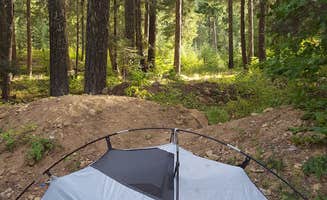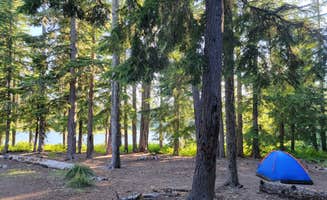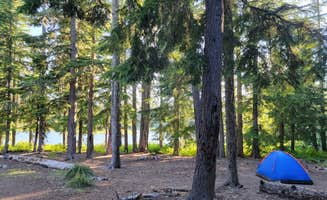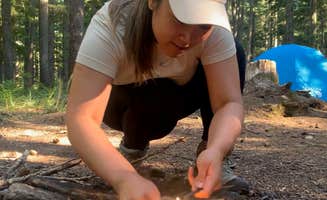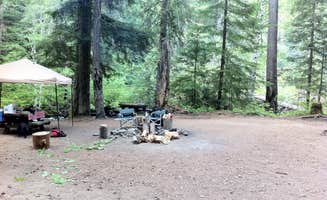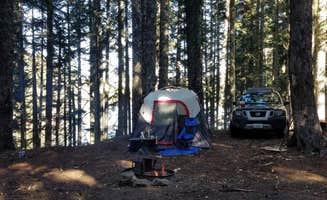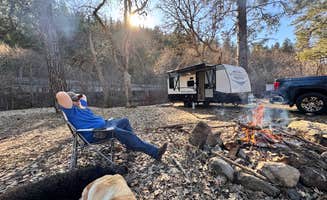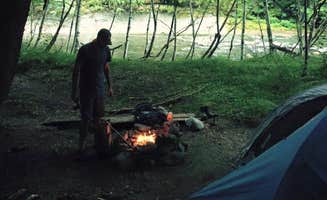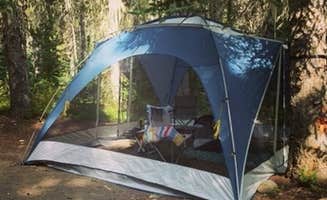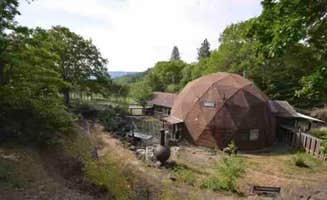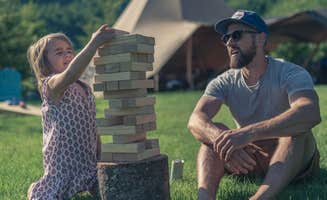Tent camping near Trout Lake, Washington ranges from established forest campgrounds to primitive dispersed sites in the Gifford Pinchot National Forest. The camping season typically runs from June through October, with most campgrounds closed during winter months due to significant snowfall at elevations ranging from 1,900 to 3,000 feet. Nighttime temperatures can drop below 40°F even in summer, requiring proper cold-weather gear for comfortable tent camping.
What to do
Fishing in alpine lakes: Council Lake offers excellent trout fishing opportunities in a clear alpine setting. "The trout fishing is good here. Boats are allowed, but electric or hand operated only," notes Juice B. who visited in July 2019. "I saw a river otter basking in the shallows, and several eagles diving for fish while I was here."
Waterfall exploration: Twin Falls Campground provides direct access to impressive waterfalls along the Lewis River. "I've never camped at the base of a waterfall before, it was beyond awesome! And the best part like 95% of the places I go is that it's FREE!" writes Jess G. The campground features walk-in sites with picnic tables and fire rings within hearing distance of the falls.
Wild huckleberry picking: During July and August, campers can gather wild huckleberries throughout the forest. "Feels very remote, can be a bit colder due to altitude, but very beautiful and tons of wild huckleberries everywhere!" reports Phelan V. about Forlorn Lakes. Peak huckleberry season typically runs from mid-July through August, with berries most abundant at higher elevations.
What campers like
Lake privacy: Many campsites offer semi-private lake access. "Campsites 16-21 are all on a larger lake with great swimming and paddling opportunities with site 17 easily being the best site in my opinion," explains Phelan V. about Forlorn Lakes. The campground features multiple small lakes with sites positioned to provide secluded water access.
Stream-side camping: Trout Creek offers sites along a year-round creek. "A quiet campsite set along Trout Lake Creek in a deeply wooded area," writes Chad L., noting it's "a family favorite." The sound of running water provides natural white noise for sleeping while keeping temperatures cooler during summer months.
Stargazing opportunities: The limited light pollution creates exceptional night sky viewing. "During the day we would go peek over the edge and could see people parking to go to the falls. You could hear a tiny bit of road noise from up there but it was very light... The stars were amazing," shares Sarah S. about dispersed camping above Panther Creek Falls. Most campsites in the area provide unobstructed views of constellations and the Milky Way on clear nights.
What you should know
Road conditions: Many campground access roads require careful navigation. "The road is a bit more than a gravel road, there are some large rocks and deep ruts to avoid," warns Phelan V. about reaching Forlorn Lakes. Similarly, at Goose Lake Campground, Brian B. notes: "Easy access on forest road- some potholes."
Water sources: No running water exists at most sites. "Bring what you'll need as there are no stores around, Trout lake is the closest facility," advises Bruce W. about camping at Forlorn Lakes. Most campers either bring their water supply or filter from nearby lakes and streams.
Temperature fluctuations: Higher elevation sites experience significant cooling after sunset. "Feels very remote, can be a bit colder due to altitude," notes Phelan V. Temperature drops of 20-30 degrees Fahrenheit from day to night are common, particularly at sites above 3,000 feet elevation.
Tips for camping with families
Best family sites: Several campgrounds offer child-friendly features. "Nice spot. Has a boat launch, great sites to put up tents. Love fishing here," shares Samantha B. about Goose Lake Campground, rating it as "Family friendly" and "Great for a day fishing trip."
Insect preparation: Yellow jackets can be problematic in late summer. "Highly recommend yellow jacket traps this late in summer. Aggressive is an understatement," warns Michael H. about his September stay at Goose Lake. Bringing mesh food covers and insect repellent will make family meals more enjoyable.
Swimming options: Council Lake provides kid-friendly swimming areas. "It's a beautiful clear water lake," notes Juice B. Similarly, at Forlorn Lakes, Brian B. reports: "The smaller lake this site backs up to is great for swimming and kayak/paddle-boarding."
Tips from RVers
Length limitations: Most forest campgrounds cannot accommodate larger RVs. "It's a bumpy windy road down to the campground. I just drove through here and I wouldn't take a car down to the campground without high clearance," warns Juice B. about Twin Falls. "Please don't try to drag a trailer down."
Alternative options: For RV campers seeking more amenities, look beyond the immediate Trout Lake area. "The site was a huge pull-through with all hookups. A Lake or a pond is your front view, the back is cliffs, prairie, and wildlife," reports Doug W. about Steamboat Lake Campground. This campground offers full hookup sites with modern facilities approximately 30 minutes from Trout Lake.
Dispersed camping preparation: RVers can find dispersed sites but must come prepared. "Like someone else said, you take the road on the right just before the parking lot and then there are a few spots just up the road which are all pretty private," explains Madeline N. about dispersed camping near Panther Creek Falls. Dispersed sites lack all services, requiring self-contained camping with proper waste disposal protocols.


